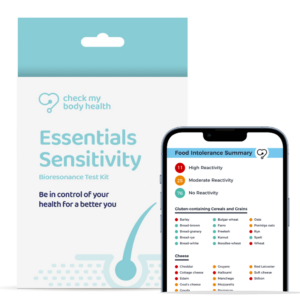
Medically reviewed by Sian Baker, Dip ION mBANT mCNHC
on April 2, 2024. To give you technically accurate, evidence-based information, content published on the Check My Body Health blog is reviewed by credentialed professionals with expertise in medical and bioscience fields.
If you’ve ever felt itchy, bloated, or had stomach cramps after a meal with parsley, an allergy to this herb might be the culprit. While thankfully rare, severe parsley allergies can cause breathing problems or worse. In this post, we’ll uncover the signs of a parsley allergy, how common it is, and how to navigate your diet if you think you might be affected.
Can you actually be allergic to parsley?
Yes, it’s possible to be allergic to parsley. Though less common than allergies to foods like nuts or shellfish, parsley allergy can occur, especially since parsley is related to other common allergenic plants in the Apiaceae family, such as celery. The naturally occurring compounds in parsley, called furocoumarins, are primarily responsible for the reactions people have. They can disrupt the digestive process in sensitive individuals and even cause skin reactions like rashes and increased sensitivity to sunlight.
How common is this allergy?
Parsley allergy, specifically, is not as well-documented or studied as allergies to more prevalent allergens like peanuts or milk. However, because parsley belongs to the same plant family as some other known allergens, individuals who are sensitive to one member of the family may potentially react to parsley as well.
Parsley Allergy & Intolerance | Signs & Symptoms
Signs & Symptoms of a Parsley Allergy or Intolerance
The symptoms of a parsley allergy can resemble those of other food allergies, including:
- Nausea, vomiting, or diarrhoea
- Hives, rash, or itchy skin
- Abdominal pain and cramps
- Breathing difficulties or tightening of the throat
- Pale or discoloured skin
- Lightheadedness or dizziness
In rare cases, anaphylaxis may occur. Unlike a food intolerance, an allergic reaction involves the immune system and can be severe or life-threatening.
What are the symptoms of a parsley intolerance?
Intolerance to parsley might not involve the immune system but can still cause discomfort. Symptoms typically include gastrointestinal issues such as:
- Stomach or intestinal pain
- Bloating
- Constipation or diarrhea
- Fatigue
What is food intolerance?
Food intolerance occurs when your body has difficulty digesting certain foods. Unlike allergies, intolerances do not involve the immune system and are generally less severe but can still cause significant discomfort.
Because parsley belongs to the Apiaceae family, which also includes carrots, celery, and fennel, some individuals might experience cross-reactivity. This means if you’re sensitive to parsley, you might also react to those related foods.
How common is a parsley intolerance?
Specific data on parsley intolerance is scarce, but food intolerances overall are quite common. Given parsley’s common use in cooking and seasoning, individuals with sensitive digestive systems might experience intolerance symptoms more frequently.
How do you test for a parsley allergy or intolerance?
To determine if you have a parsley allergy or intolerance, you can:
- Consult with a doctor, especially an allergist, who can perform tests and consider your medical history.
- Keep a food diary to track your intake and any subsequent symptoms.
- Try an elimination diet, removing parsley from your diet to see if symptoms improve.
- Consider a food intolerance test for a more comprehensive understanding of your sensitivities.
What should you do if you think you have a parsley allergy or intolerance?
If you suspect an allergy or intolerance to parsley, eliminating it from your diet and seeking medical advice is crucial for confirming your suspicions and preventing potential health risks.
What foods should you avoid if you have a parsley allergy or intolerance?
Avoiding parsley and foods containing it is key. This includes dishes where parsley is used as a garnish or seasoning, such as in soups, sauces, and salads.
Be a savvy label reader! Parsley can sometimes hide in pre-prepared foods and spice mixes. Look out for terms like ‘vegetable extract’, ‘natural flavouring’, or ‘herbal blend’, as these could contain parsley.
10 alternatives to parsley
- Cilantro (for those not allergic to it)
- Chervil
- Basil
- Tarragon
- Oregano
- Mint
- Dill
- Green onions
- Celery leaves
- Arugula
How to test if you have a parsley allergy or intolerance
Discovering whether you have an allergy or intolerance involves monitoring symptoms, possibly eliminating parsley from your diet, and consulting with a healthcare provider for testing and diagnosis.
For those concerned they might have a parsley allergy or intolerance, consulting with a healthcare provider and possibly undergoing testing is advised. Remember, managing your dietary intake and being aware of ingredients in your food can help prevent uncomfortable or even dangerous reactions. Consider trying one of Check My Body Health’s intolerance tests to explore your food sensitivities further.




